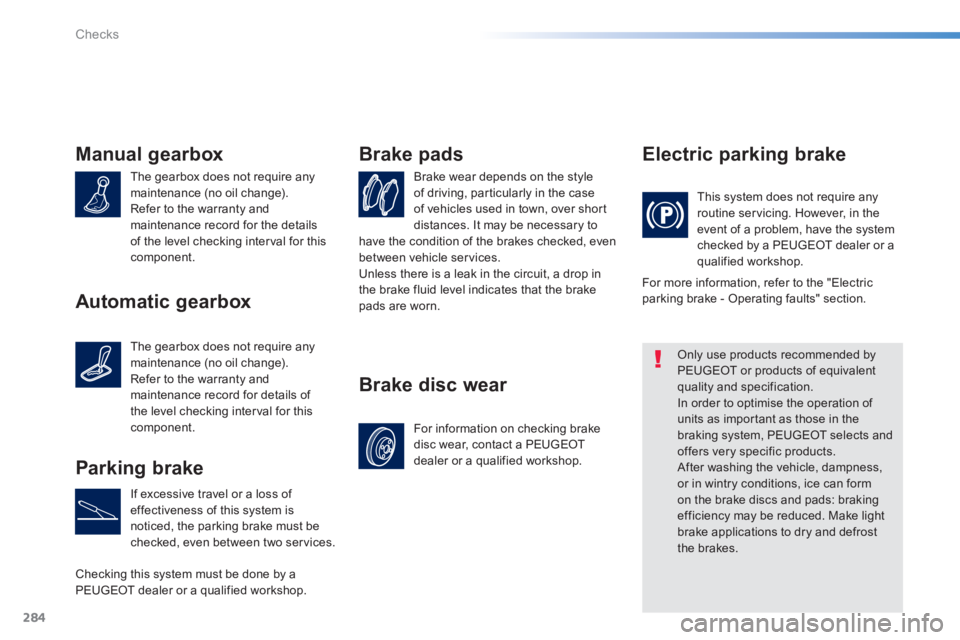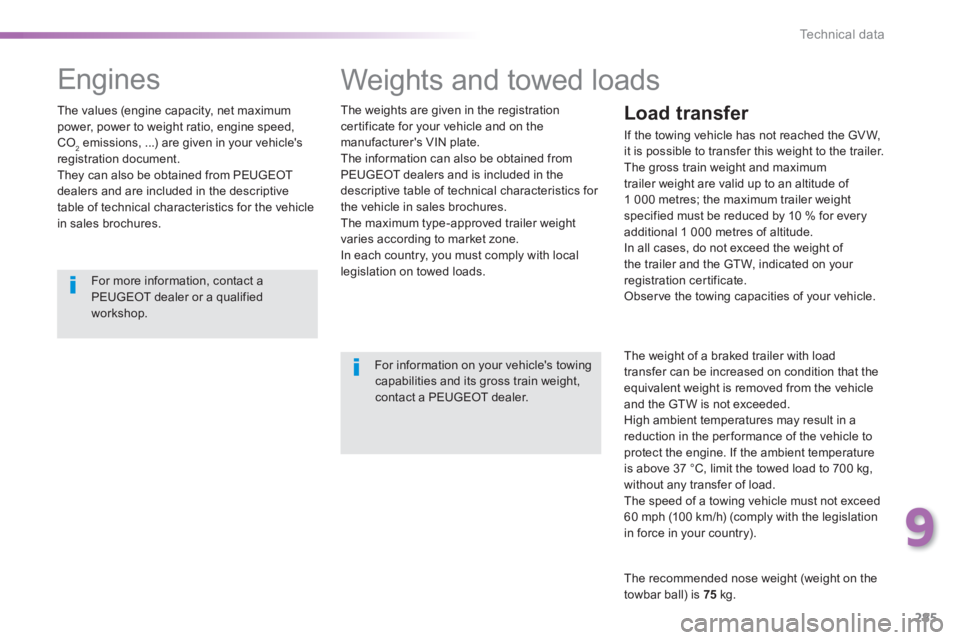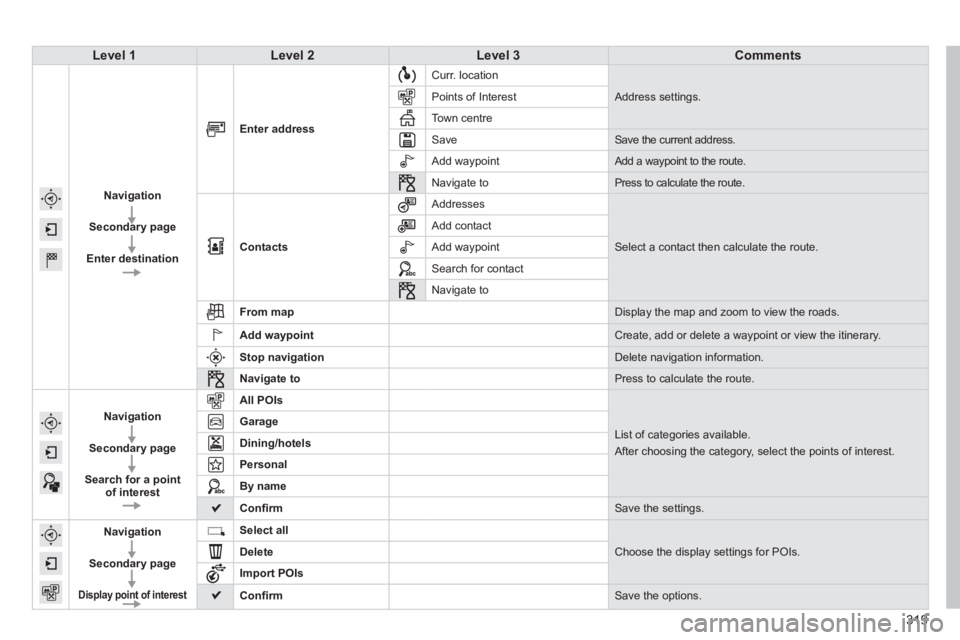Page 269 of 400
267
8
Checks
Bonnet
Before doing anything under the bonnet, switch off the Stop & Start system to avoid any risk of injury resulting from an automatic change to START mode.
Opening
Closing
Take the stay out of its support slot. Clip the stay back into its housing. Lower the bonnet and release it at the end of its travel. Pull on the bonnet to check that it has latched correctly.
Unclip the stay from its housing and place it in the support slot to hold the bonnet open.
Do not open the bonnet under very windy conditions.
When the engine is hot, handle the exterior safety catch and the stay with care (risk of burns). To avoid damaging electrical units, it is strictly forbidden to use a high pressure jet wash under the bonnet.
Pull the safety catch towards you, then raise the bonnet.
Open the door.
Pull the release lever, located at the bottom of the door aperture, towards you.
Page 281 of 400
279
8
Checks
Version with DENON bass woofer unit
- Disconnect the connector: move the orange clip towards the rear, then while pressing the black part (located on top of the orange clip) pull the connector. - Remove the yellow screw retaining the woofer unit. For reassembly, first slacken the yellow screw a few turns.
- Remove the woofer from the boot. - Remove or raise the storage well.
Page 286 of 400

284
Checks
Manual gearbox
The gearbox does not require any maintenance (no oil change). Refer to the warranty and maintenance record for the details of the level checking interval for this component.
Brake wear depends on the style of driving, particularly in the case of vehicles used in town, over short distances. It may be necessary to
Brake pads
For information on checking brake disc wear, contact a PEUGEOT dealer or a qualified workshop.
Brake disc wear
Electric parking brake
This system does not require any routine servicing. However, in the event of a problem, have the system checked by a PEUGEOT dealer or a qualified workshop.
Only use products recommended by PEUGEOT or products of equivalent quality and specification. In order to optimise the operation of units as important as those in the
braking system, PEUGEOT selects and offers very specific products. After washing the vehicle, dampness, or in wintry conditions, ice can form on the brake discs and pads: braking efficiency may be reduced. Make light brake applications to dry and defrost the brakes.
Parking brake
If excessive travel or a loss of effectiveness of this system is noticed, the parking brake must be checked, even between two services.
Checking this system must be done by a PEUGEOT dealer or a qualified workshop.
have the condition of the brakes checked, even between vehicle services. Unless there is a leak in the circuit, a drop in the brake fluid level indicates that the brake pads are worn.
For more information, refer to the "Electric parking brake - Operating faults" section. Automatic gearbox
The gearbox does not require any maintenance (no oil change). Refer to the warranty and maintenance record for details of the level checking interval for this component.
Page 287 of 400

285
9
Technical data
Weights and towed loads
The weights are given in the registration certificate for your vehicle and on the manufacturer's VIN plate. The information can also be obtained from PEUGEOT dealers and is included in the descriptive table of technical characteristics for the vehicle in sales brochures. The maximum type-approved trailer weight
varies according to market zone. In each country, you must comply with local legislation on towed loads.
For information on your vehicle's towing capabilities and its gross train weight, contact a PEUGEOT dealer.
Load transfer
If the towing vehicle has not reached the GV W, it is possible to transfer this weight to the trailer. The gross train weight and maximum trailer weight are valid up to an altitude of 1 000 metres; the maximum trailer weight specified must be reduced by 10 % for every additional 1 000 metres of altitude. In all cases, do not exceed the weight of the trailer and the GTW, indicated on your registration certificate. Observe the towing capacities of your vehicle.
The weight of a braked trailer with load transfer can be increased on condition that the equivalent weight is removed from the vehicle and the GTW is not exceeded. High ambient temperatures may result in a reduction in the per formance of the vehicle to protect the engine. If the ambient temperature is above 37 °C, limit the towed load to 700 kg, without any transfer of load. The speed of a towing vehicle must not exceed 60 mph (100 km/h) (comply with the legislation
in force in your country).
The recommended nose weight (weight on the
towbar ball) is 75 kg.
Engines
The values (engine capacity, net maximum power, power to weight ratio, engine speed, CO2 emissions, ...) are given in your vehicle's registration document. They can also be obtained from PEUGEOT dealers and are included in the descriptive table of technical characteristics for the vehicle in sales brochures.
For more information, contact a PEUGEOT dealer or a qualified workshop.
Page 321 of 400

319
Level 1Level 2Level 3Comments
Navigation
Secondary page
Enter destination
Enter address
Curr. location
Address settings . Points of Interest
Town centre
Save Save the current address.
Add waypoint Add a waypoint to the route.
Navigate to Press to calculate the route.
Contacts
Addresses
Select a contact then calculate the route.
Add contact
Add waypoint
Search for contact
Navigate to
From map Display the map and zoom to view the roads.
Add waypoint Create, add or delete a waypoint or view the itinerary.
Stop navigation Delete navigation information.
Navigate to Press to calculate the route.
Navigation
Secondary page
Search for a point of interest
All POIs
List of categories available.
After choosing the category, select the points of interest.
Garage
Dining/hotels
Personal
By name
Confi rm Save the settings.
Navigation
Secondary page
Display point of interest Display point of interest Display point of interest
Select all
Choose the display settings for POIs. Delete
Import POIs
Confi rm Save the options.
Page 324 of 400
05
322
Towards a new destination
Choosing a new destination
Select " Enter destination ".
Select " Save " to save the address entered as a contact entry.
The system allows up to 200 entries.
Select " Confi rm " or press " Show route on map " to start navigation guidance.
Select " Address ".
Select the " Country: " from the list offered then in the same way:
the " City: " or its post code, the " Road: ", the " N°: ". Confi rm each time.
Select " Navigate to ".
Choose the restriction criteria: " Include tollroads ", " Include ferries ", " Traffi c ", " Strict ", " Close ".
Choose the navigation criteria: " Fastest " or " Shortest " or " Time/distance " or " Ecological ".
To delete navigation information, press on " Settings " then " Stop navigation ".
To restore the navigation information press on " Settings " then " Resume navigation ".
Press on Navigation to display the primary page then go to the secondary page.
NAVIGATION - GUIDANCE
Page 325 of 400
05
323
Towards a recent destination Towards a contact
Navigation towards a contact imported from a telephone is only possible if the address entered is compatible with the system.
Select " Enter destination ".
Select an address from the list offered.
Select " Enter destination ".
Select " Contacts ".
Select a destination from the contacts in the list offered.
Select " Navigate to ".
Select the criteria then " Confi rm " to start guidance.
Select " Navigate to ".
Select the criteria then " Confi rm " or press " Show route on map " to start guidance.
Press on Navigation to display the primary page then go to the secondary page.
Press on Navigation to display the primary page then go to the secondary page.
NAVIGATION - GUIDANCE
Page 326 of 400
05
Towards GPS coordinates Towards a point on the map
Select " Enter destination ".
Select " Address ".
Enter the " Longitude: " then the " Latitude: ".
Select " Navigate to ".
Select the criteria then " Confi rm " or press " Show route on map " to start guidance.
Select " Enter destination ".
Select " From map ".
Zoom in on the map then select the point.
Press on Navigation to display the primary page then go to the secondary page. Press on Navigation to display the primary page then go to the secondary page.
A long press displays the surrounding tourist attractions.
NAVIGATION - GUIDANCE
324